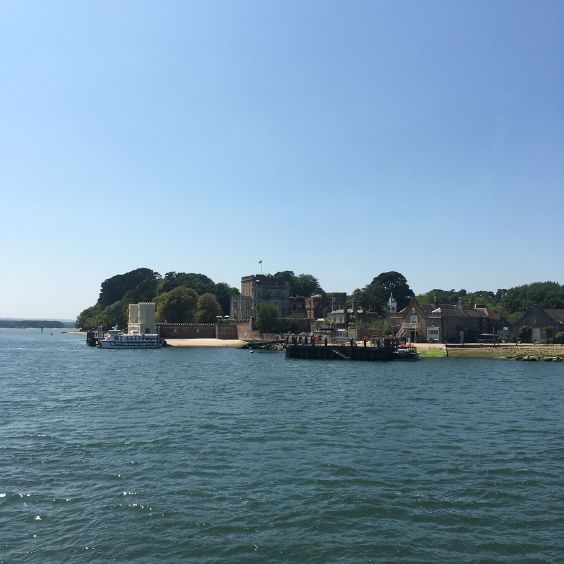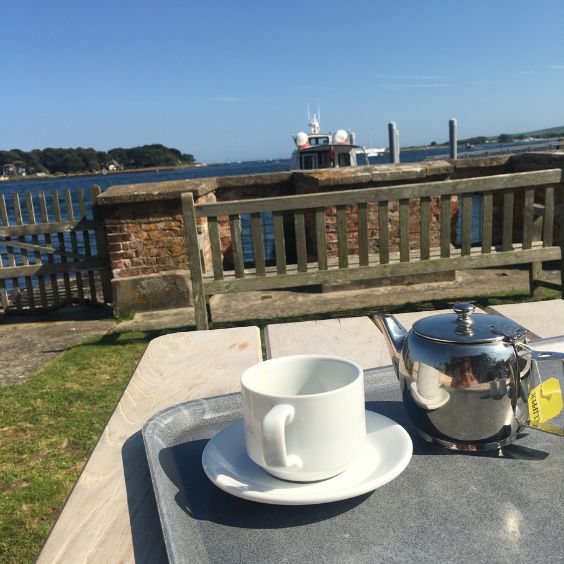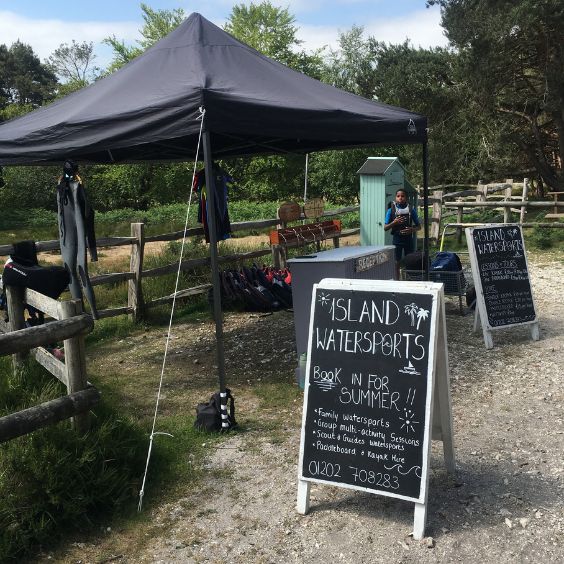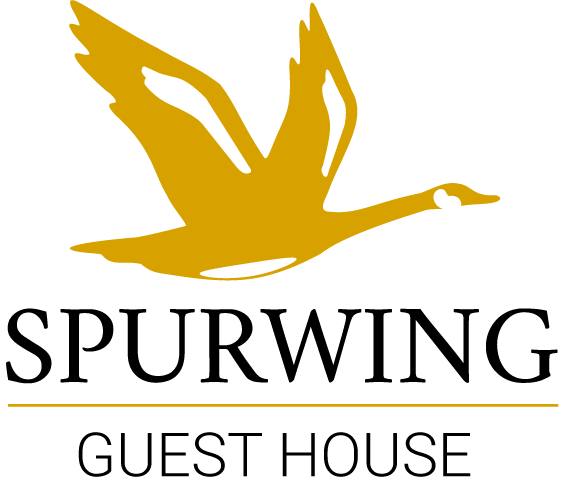Brownsea Island, owned by the National Trust, is a very special place to visit. In fact, recently in the space of a week, I went twice.
I went once with my mum for a leisurely walk to explore the island on foot, and again shortly afterwards kayaking with my 10-year-old son.
The kayaking was great fun! My son and I kayaked from Brownsea Island to the neighbouring Furzey Island with ‘The Watersports Academy’, which you can read about below.
On both trips, I looked forward to the ferry journey, as well as seeing red squirrels, which Brownsea Island is well known for.
I highly recommend a visit there if staying with us!
Getting to Brownsea Island
 From our guest house we drove to Poole Quay Visitor Car Park (BH15 1SB). Once parked we walked to the Quay where we immediately spotted the bright yellow Brownsea kiosk and ferry.
From our guest house we drove to Poole Quay Visitor Car Park (BH15 1SB). Once parked we walked to the Quay where we immediately spotted the bright yellow Brownsea kiosk and ferry.
The ferry operates a ‘walk on basis’, therefore we just queued up and got on board. The National Trust ferry staff were friendly and helpful.
There is an opportunity to ‘fast track pay’ for the ferry and the Brownsea Island entrance fee on board the ferry, but to be honest there wasn’t a need to as my mum and I simply paid on arrival at the island reception.
Ferry and Entrance Fee
Please refer to the Brownsea website for up-to-date fees.
Sensibly my mum is a National Trust member, so she only paid for the ferry. Non-members, like myself presently, pay for the ferry as well as the Brownsea Island entrance fee.
The ferry journey was approximately 20 minutes long, and what a glorious day we chose.
Brownsea Map and Suggested Walks
 We collected a map on arrival from the reception, which was very helpful for our walk.
We collected a map on arrival from the reception, which was very helpful for our walk.
There were five suggested walks on the map:
- Wildlife and Wetlands Walk (45 minutes, some steps)
- Viewpoints and Woodland Walk (40 minutes)
- Heathland Walk (40 minutes)
- Scouting and Maryland Walk (35 minutes)
- Woodland Red Squirrel Walk (15 minutes)
We decided to firstly take the Wildlife and Wetlands Walk.
We took a midday ferry, so we had half a day to explore. On reflection I believe the walk we chose, being wildlife and bird enthusiasts, was perfect for our limited time.
Before writing anymore about our fabulous afternoon on Brownsea Island, let’s look in more detail at Brownsea’s location, its history and its wonderful wildlife.
The Location of Brownsea Island
 Brownsea Island, owned by the National Trust, lies in Poole Harbour (the largest natural harbour in Europe) opposite the town of Poole in Dorset, England. It is the largest of the five islands in the harbour, including Furzey Island, Green Island, Round Island and Long Island.
Brownsea Island, owned by the National Trust, lies in Poole Harbour (the largest natural harbour in Europe) opposite the town of Poole in Dorset, England. It is the largest of the five islands in the harbour, including Furzey Island, Green Island, Round Island and Long Island.
The island is one and a half miles long and three quarters of a mile wide and consists of 500 acres of woodland (pine and oak), heathland and saltmarsh.
The entire island, except the Church and a few other leased or managed buildings, is owned by the National Trust. The northern portion of the island is a nature reserve managed by Dorset Wildlife Trust and is an important habitat for birds.
A small portion to the southeast of the island, along with Brownsea Castle, is leased to the John Lewis Partnership for use as a holiday hotel by partners and is not open to the public.
History of Brownsea Island
The first record of inhabitants on Brownsea Island occurred in the 9th Century, when a small chapel and hermitage were built by monks from Cerne Abbey near Dorchester.
After the dissolution of monasteries, control of Brownsea passed to the Crown. Henry V111 recognised the island’s strategic importance of guarding the entrance to the expanding port of Poole. To avoid invasion from Europe, the island was fortified in 1547 by means of a blockhouse, which became known as Brownsea Castle.
William Benson, an amateur architect, bought the island for £300 and converted the castle into a private residence in 1726. He was responsible for introducing many varieties of trees to the island.
Between then and 1962, when it was offered to the National Trust, there were many owners giving it a rich history.
Owners included Colonel Waugh, who built St Mary’s Church, the Villa (now the HQ of Dorset Wildlife), the farm (now the Visitor Centre), Maryland Village, which was named after his first wife, a pottery on the south shore and he built the sea wall to enclose St Andrew’s Bay (now the lagoon).
 The mock Tudor entrance was also added by William Waugh in the mid-1850s.
The mock Tudor entrance was also added by William Waugh in the mid-1850s.
In 1901 Marcus Van Raalte bought Brownsea as a holiday home for his only son Charles, who was a wealthy stockbroker. It was a time of Edwardian splendour. He gave Robert Baden-Powell permission to hold an experiment camp for 20 boys in 1907 which led to the founding of Scouting in 1908 and guiding in 1910.
After the death of Charles in 1907, his widow Florence remained there until 1925 and finally in 1927 Brownsea was bought by Mrs Mary Bonham-Christie for £125,000 as a place she could live as a recluse. All the islanders were given notice, all the animals were let loose, and even the boy scouts were forbidden too. Nature took over and decay set in.
A fire in 1934 caused devastation. Much of the island was reduced to ashes. Luckily the church, the villa and the castle were not damaged.
During WW2 large flares were placed on the western end of the island to mislead Luftwaffe bombers away from the port of Poole.
In 1961, Mrs Mary Bonham-Christie died at 98 years old. Soon afterwards in 1962 Brownsea was offered to the National Trust, and after much clearance work, the island was opened to the public on 15th May 1963 by Lady Baden-Powell widow of Robert Baden-Powell.
A permanent 49-acre scout camp opened in 1963.
Currently John Lewis Partnership lease the castle as a hotel for their employees and Dorset Wildlife Trust have a nature reserve. The church remains the property of the Church of England.
Wildlife on Brownsea Island
 Brownsea Island, owned by the National Trust, is one of the few places in Southern England where indigenous red squirrels survive, largely because non-native grey squirrels have never been introduced to the island. (Please see below more spectacular photos taken at Brownsea Island by ‘Enthusiast Photographer’ David Powell)
Brownsea Island, owned by the National Trust, is one of the few places in Southern England where indigenous red squirrels survive, largely because non-native grey squirrels have never been introduced to the island. (Please see below more spectacular photos taken at Brownsea Island by ‘Enthusiast Photographer’ David Powell)
Brownsea also has a small ornamental population of peacocks.
The lagoon is noted for the large population of common tern and sandwich tern in summer, and a very large flock of avocet in winter.
Not seen on our trip, but there is a population of non-native Sika deer on the island too.
The Squabbling Common Terns and our Red Squirrel Sighting
Continuing our personal account of our visit to Brownsea Island, my mum and I decided to walk on the Wildlife and Wetlands Walk.
On this walk we couldn’t help but get distracted by the squabbling common terns. They were particularly vocal and noisy. They can be highly aggressive during the breeding season and will defend their nest against much larger birds.
Common terns usually arrive on Brownsea Island from mid-April onwards after a migratory flight of 5,000 miles or more from the African coast.
 It was fascinating watching the terns from the hides in The Lagoon.
It was fascinating watching the terns from the hides in The Lagoon.
 After spending a considerable amount of time watching the adult terns with their chicks, we headed up some steps to a very memorable viewpoint of Poole Harbour. It was spectacular! My mum and I shared the bench for some time enjoying the window of beauty between the trees with all the boats and the Port of Poole in the background.
After spending a considerable amount of time watching the adult terns with their chicks, we headed up some steps to a very memorable viewpoint of Poole Harbour. It was spectacular! My mum and I shared the bench for some time enjoying the window of beauty between the trees with all the boats and the Port of Poole in the background.
 Finally, we returned to the Dorset Wildlife Trust entrance where we started. In need of a cuppa and aware of the time, and not wanting to miss the last ferry back to Poole at 5pm, we quickly went to the Villano Café overlooking the harbour.
Finally, we returned to the Dorset Wildlife Trust entrance where we started. In need of a cuppa and aware of the time, and not wanting to miss the last ferry back to Poole at 5pm, we quickly went to the Villano Café overlooking the harbour.
Aware that we had not seen any red squirrels, and desperately wanting to see some before we left, I asked a lady working in the café where to hang out if we wanted to see one. After hearing the best place was behind the church, we drank up and quickly headed there.
When there, there was a gentleman camouflaged under the trees with a telescopic camera lens. Getting our attention, he pointing to a beautiful bushy tailed red squirrel! We were so pleased. However, with a blink of an eye it disappeared before I could capture it on my mobile.
It turned out that fortunately the gentleman was David Powell an ‘Enthusiast Photographer’.
We were so grateful to have met him at Brownsea as he kindly shared his spectacular red squirrel photos with us so we could share them with others on our blog page on our website.
We would like to sincerely thank David Powell for these wonderful photos!



The Watersports Academy
 My second visit to Brownsea Island, owned by the National Trust, was with my 10-year-old son. During half term we signed up for a National Trust ‘Paddle and Cake’.
My second visit to Brownsea Island, owned by the National Trust, was with my 10-year-old son. During half term we signed up for a National Trust ‘Paddle and Cake’.
We had such an amazing time with Sophie and Charlie, the instructors from The Watersports Academy.
Firstly, we sailed around the neighbouring Furzey Island in Kayaks, and then had a paddleboard taster.
Both of which we thoroughly enjoyed, although personally a lesson or two more wouldn’t go a miss on the paddleboard for me, which my son would agree with, I’m sure!
If you are interested in a similar water sports session from Brownsea Island, you can read about it here on The Watersports Academy website.
Or you can give them a call on 01202 708283.
At Sandbanks they offer sailing, kayaking, winging, paddle boarding, wakeboarding, waterskiing, powerboating, bike hire, yacht charter and windsurfing.
Access on Brownsea Island
There are some slopes and uneven ground. There is a pre-bookable wheelchair friendly service, all-terrain manual wheelchairs available to hire and a squirrel mini-bus offering tours and hop on/hop off service.
Please refer to their access statement.
If you are a National Trust member, please refer to our other blogs on nearby tourist attractions including the country house and estate Kingston Lacy, Corfe Castle, Thomas Hardy’s Cottage and his house ‘Max Gate’, as well as TE Lawrence’s ‘hut’ Clouds Hill and Studland Bay.
If you enjoyed reading this blog and would like to learn about updates, events in the area or last-minute availability at our Dorset B&B, Spurwing Guest House, you can subscribe to our mailing list.









